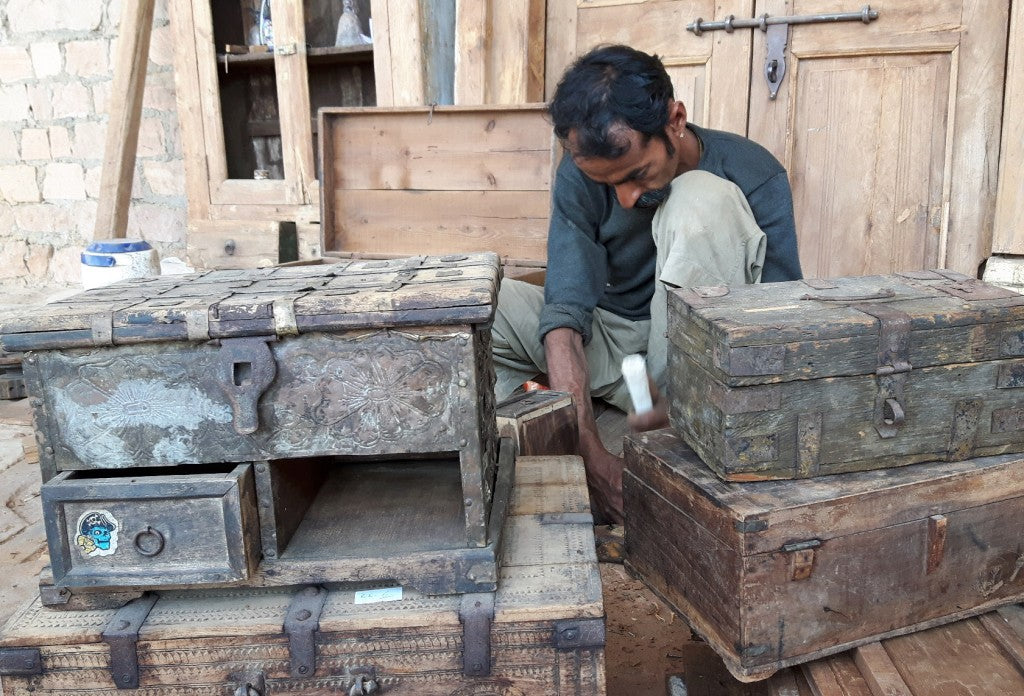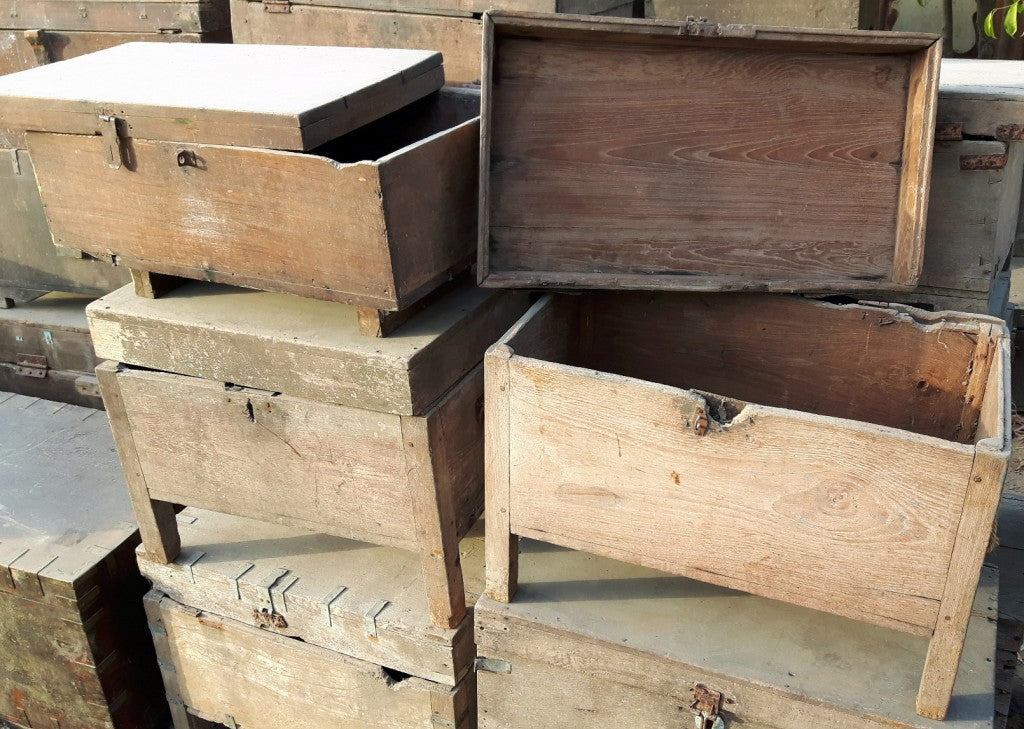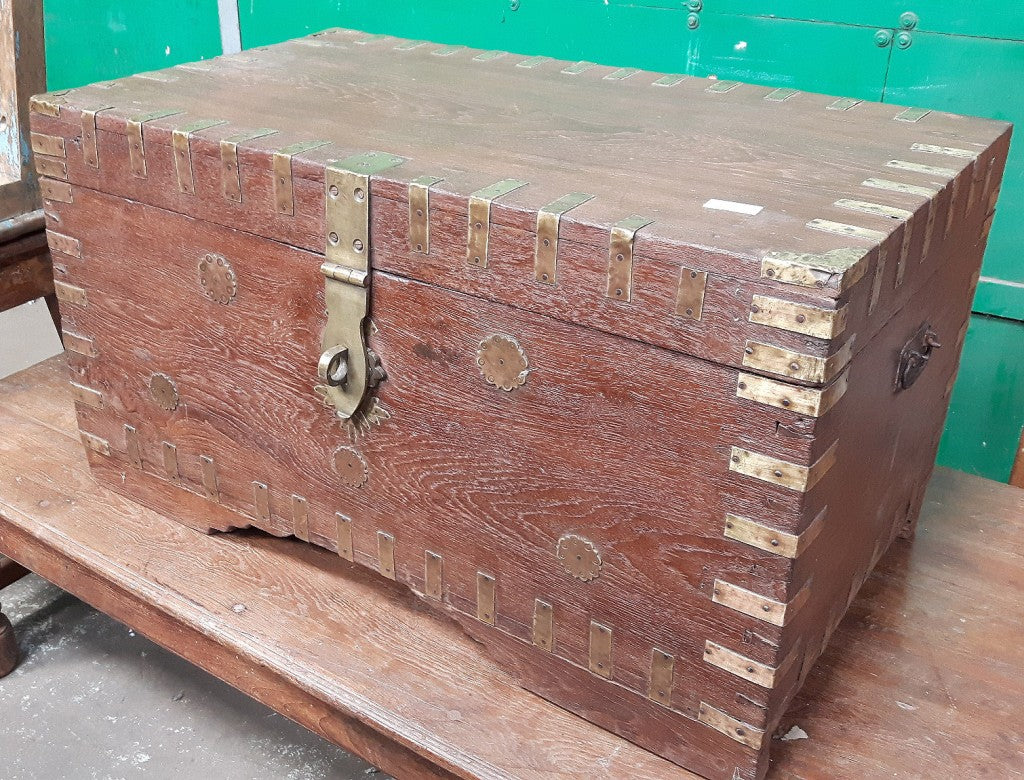Meet master carpenter and restorer Umaida Ram. Umaida is managing the restoration of what's probably our single biggest purchase of
wooden chests. 142 antique wooden chests we acquired in February.
Umaida is 42 and from Barmer, a town in the Thar desert in western Rajasthan, NW India. He has been a carpenter for 25 years. He comes from a long line of skilled artesans: his father was a carpenter, as was his grandfather and his grandfather's father. His brother is a carpenter and so is his 17 year old son. So working with wood is pretty much in his blood.

Umaida is repairing a small collection of antique Rajasthani wooden boxes
We've gained a reputation for specialising in antique chests travel trunks and
old boxes and no trip is ever complete without buying a collection of chests. Our chests are delivered all over the UK and Europe. We are fortunate enough to have had our chests and trunks featured in TV dramas and blockbuster feature films and several have been acquired by museums across the world.

Some of the antique teak chests Carl bought
When Carl heard there was a large collection of
antique chests and storage boxes from the south of India he did not hesitate to buy the entire lot. Golden teak, considered to be the best teak in the world, was imported into Madras south east India from Burma, via Calcutta, in the 1800s and made into all sorts of boxes: merchant's chests, storage chests and wedding chests by carpenters and cabinet makers in the Indian state of Andhra Pradesh.

Umaida's skill and expertise allows Carl to buy antique and vintage furniture that needs a small team of carpenters and restorers to bring them back to life without loosing any of the character and patina they have acquired over 100 years of use. Buying items that need to be fully restored may seem risky, but we have total confidence in our carpenters' abilities. Our sympathetic restoration will allow the chest's new owners to enjoy them for another lifetime. Many unskilled carpenters would use inferior materials and the wrong techniques. For these old chests we have used solid brass hinges, screws and rings for the small internal compartments, most other restorers would use iron. Often bun feet are added to the base of a chest where a plinth would have been and new brass edging added where the original has worn away. We always like to keep the chest as original as possible so would simply leave the chest without feet and not replace decorative finishing.

Work in progress on one of the wedding chests, Umaida has replaced a compartment's lid and some of the top edges of the chest
Umaida has worked with new wooden gifts and handicrafts, but loves working with antique and vintage furniture and architectural doors and windows. In 2012-13 he worked in Mumbai and Goa, but returned to Rajasthan to return to working with old furniture.
His role in the team is the most skilful as he is responsible for repairing the main structure and surfaces of the chests and tightening joints, the other three members of the team prepare and finish the restoration work.

Here are a few of the fully restored antique teak chests

Top tip: when restoring a chest work your way up from the base once it has been strengthened.
Biggest challenge when working with an old chest: re-securing hinges to the back of a chest when it has been split by the hinge's screws. This is the same part of restoring Bill our UK restorer said was the most challenging. Both use the same technique of replacing the upper part of the back panel with reclaimed teak before re-securing the hinges.

Typically the lid has broken aay from the chest. Substantial work is needed to reinforce the back so the hinges can be secured to the back of the chest
What happens when you restore a chest:
- clean the chest thoroughly and a precautionary treatment for pests
- rub down the chest with sandpaper
- repair structurally (often replacing panels from the base)
- repair internal compartments
- repair surface damage (broken corners)
- wash and sandpaper again
- add old brass hardware
- wax and polish

Umaida can restore 1 to 2 large chests a day. The rest of the team will prepare and finish 10 chests in two days.
Some items need basic work to clean and remove surface dirt and grime and finish with waxing and a good polish. Others need remedial work to replace broken glass, renew drawer runners, tighten joints. Extreme restoration may involve reconstructing a chest's panels, remaking doors and drawers from reclaimed teak from old furniture. We buy a selection needing a wide variety of work.
See our full range of
vintage and antique wooden chests


 Umaida's skill and expertise allows Carl to buy antique and vintage furniture that needs a small team of carpenters and restorers to bring them back to life without loosing any of the character and patina they have acquired over 100 years of use. Buying items that need to be fully restored may seem risky, but we have total confidence in our carpenters' abilities. Our sympathetic restoration will allow the chest's new owners to enjoy them for another lifetime. Many unskilled carpenters would use inferior materials and the wrong techniques. For these old chests we have used solid brass hinges, screws and rings for the small internal compartments, most other restorers would use iron. Often bun feet are added to the base of a chest where a plinth would have been and new brass edging added where the original has worn away. We always like to keep the chest as original as possible so would simply leave the chest without feet and not replace decorative finishing.
Umaida's skill and expertise allows Carl to buy antique and vintage furniture that needs a small team of carpenters and restorers to bring them back to life without loosing any of the character and patina they have acquired over 100 years of use. Buying items that need to be fully restored may seem risky, but we have total confidence in our carpenters' abilities. Our sympathetic restoration will allow the chest's new owners to enjoy them for another lifetime. Many unskilled carpenters would use inferior materials and the wrong techniques. For these old chests we have used solid brass hinges, screws and rings for the small internal compartments, most other restorers would use iron. Often bun feet are added to the base of a chest where a plinth would have been and new brass edging added where the original has worn away. We always like to keep the chest as original as possible so would simply leave the chest without feet and not replace decorative finishing.
 Work in progress on one of the wedding chests, Umaida has replaced a compartment's lid and some of the top edges of the chest
Work in progress on one of the wedding chests, Umaida has replaced a compartment's lid and some of the top edges of the chest Top tip: when restoring a chest work your way up from the base once it has been strengthened.
Biggest challenge when working with an old chest: re-securing hinges to the back of a chest when it has been split by the hinge's screws. This is the same part of restoring Bill our UK restorer said was the most challenging. Both use the same technique of replacing the upper part of the back panel with reclaimed teak before re-securing the hinges.
Top tip: when restoring a chest work your way up from the base once it has been strengthened.
Biggest challenge when working with an old chest: re-securing hinges to the back of a chest when it has been split by the hinge's screws. This is the same part of restoring Bill our UK restorer said was the most challenging. Both use the same technique of replacing the upper part of the back panel with reclaimed teak before re-securing the hinges.
 Typically the lid has broken aay from the chest. Substantial work is needed to reinforce the back so the hinges can be secured to the back of the chest
Typically the lid has broken aay from the chest. Substantial work is needed to reinforce the back so the hinges can be secured to the back of the chest Umaida can restore 1 to 2 large chests a day. The rest of the team will prepare and finish 10 chests in two days.
Some items need basic work to clean and remove surface dirt and grime and finish with waxing and a good polish. Others need remedial work to replace broken glass, renew drawer runners, tighten joints. Extreme restoration may involve reconstructing a chest's panels, remaking doors and drawers from reclaimed teak from old furniture. We buy a selection needing a wide variety of work.
See our full range of vintage and antique wooden chests
Umaida can restore 1 to 2 large chests a day. The rest of the team will prepare and finish 10 chests in two days.
Some items need basic work to clean and remove surface dirt and grime and finish with waxing and a good polish. Others need remedial work to replace broken glass, renew drawer runners, tighten joints. Extreme restoration may involve reconstructing a chest's panels, remaking doors and drawers from reclaimed teak from old furniture. We buy a selection needing a wide variety of work.
See our full range of vintage and antique wooden chests





















